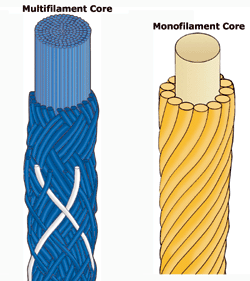|
|

Knowledge Can Be Power
When it Comes to Racket Stringing
By Steve Crandall
Vice President, Sales & Marketing
Ashaway Racket Strings

This multifilament core of Ashaway's SuperNick® XL Pro squash string (left) offers a more lively response, and more power, than that of a nylon monofilament core (right). |
As we get into the groove of another squash season, it's a good time to get back to basics and review the fundamentals of squash string and stringing. The following question from a reader, submitted through the "Ask the Racket String Expert" forum on the Ashaway web site, gives me the perfect opportunity to do just that.
The reader asks: I know thicker gauge strings are more durable, but have less bite...but does the string gauge used in a squash racket have any effect on the power of the racket?
My answer to this question may surprise you. Simply put, the answer is: not as much as people might believe.
When it comes to string gauge you have two choices: thin or thick. Thin, in squash, means 18 gauge, which is anywhere from 1.06 mm to 1.15 mm in diameter. Thick means 17 gauge, which ranges from 1.16 mm to 1.25 mm. As the reader indicated, the most common -- and practical -- reason players choose a thicker string is for durability.
Readers who have been following this column for the past five years may recall my saying, that with all other things being equal, thinner strings do provide more power, while thicker strings provide more control and durability. Thinner string is bouncier. When you hit the ball, the string stretches back, then suddenly springs forward. This "trampoline effect" is where power comes from. Thinner strings traditionally allow for more stretch, and hence, more power.
But, while thin strings are perceived as livelier, in this day of advanced material technologies and innovative string construction, all things are not equal, and stringing tension and string material (the type of fiber or filament that the string is made from) play a much bigger role in generating power than gauge alone.
Stringing tension also utilizes the trampoline effect to affect the racket's power -- only to a much larger degree than gauge. By stringing your racket at a looser tension, you allow for more stretch on impact, increasing the power behind the ball as it is launched off the face of the racket.
If you are serious about adding more power to your squash game, another element you should be looking at is how the core of your squash string is constructed, and what material it is made from. This is because the core is the central load-bearing member, which provides strength, determines the string's stiffness or resiliency, and is the source of the racket's power.
There are two types of core construction - monofilament and multifilament. A monofilament core is usually a single, heavy nylon fiber, similar to monofilament fishing line. Monofilament strings are durable, but traditionally quite stiff, and for this reason have fallen out of favor among squash players.
Multifilament cores are made from very thin fibers twisted together, that produce a soft, resilient feel and better dynamic elasticity. This means that even at relatively high tension, where control is maximized, they still generate good power.
Core material is the next most important element in determining string power. Most cores are made of nylon, but some manufacturers offer different materials that exhibit other performance characteristics. For example, the Zyex® fiber core of Ashaway’s PowerNick(tm) string line is made from a polymer called polyetheretherketone (or PEEK, for short). PEEK is stiffer than nylon multifilaments, but generates much more power than nylon monofilaments. This material comprises resilient, yet compact fibers that allow for the manufacturing of thin and lively cores for squash strings. And because it is durable, it is a good choice for both chronic string breakers and players who want to add more power to their game.
In our next column we will discuss the flip side of this issue, which is how string gauge, tension, materials and construction influence control. In the meantime, keep your questions coming.
This article previously appeared in Squash Magazine.
|